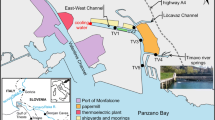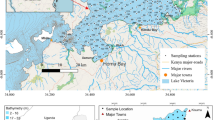Abstract
The Thames Estuary (UK) is an industrialized, macrotidal ecosystem characterized by a long history of metal pollution. Nevertheless, a holistic understanding of the metal fate is still missing. This study aims at identifying the main environmental mechanisms affecting metal behaviour in the Thames Estuary using copper and zinc as representative examples. A suite of multivariate statistical analyses performed on data from long-term monitoring of metal distribution in the estuary indicated that total metal concentrations are primarily correlated with suspended solids, being thus indirectly influenced by the interaction between freshwater discharge and the tide. These data were used to set up a three-dimensional hydrodynamic and water quality model to simulate the transport of sediments and metals within the estuary. Model results ratify that high metal concentrations might occur in the central part of the estuary as consequence of fine sediment resuspension. Such an effect of the hydrodynamics is highlighted by the differences between months characterized by low or high river discharge as well as neap or spring tide. We discuss the physical mechanisms of such transport processes and their direct implication for the management of sediment and metal contamination in estuarine areas especially in terms of long-term analysis. Developing a model able to assess future trends helps in planning the correct strategies for recovery and maintenance. Further research is needed to improve the accuracy of models of this kind as well as to investigate the potential effects of climate change for this and other similar systems.








Similar content being viewed by others
References
Attrill, M.J., and R.M. Thomes. 1995. Heavy metal concentrations in sediment from the Thames Estuary, UK. Mar Pollut Bullet 30(11): 742–744.
Attrill, M.J., S.D. Rundle, and R.M. Thomas. 1996. The influence of drought-induced low freshwater flow on an upper-estuarine macroinvertebrate community. Water Res 30(2): 261–268.
Baugh, J.V., and M. Littlewood. 2005. Development of a cohesive sediment transport model of the Thames Estuary. American Society of Civil Engineers.
Baugh, J., N. Feates, M. Littlewood, and J. Spearman. 2013. The fine sediment regime of the Thames Estuary–a clearer understanding. Ocean Coast Manag 79: 10–19.
Baugh, J.V., and A.J. Manning. 2007. An assessment of a new settling velocity parameterisation for cohesive sediment transport modeling. Cont Shelf Res 27(13): 1835–1855.
Benoit, G., S. Oktay-Marshall, A. Cantu, E. Hood, C. Coleman, M. Corapcioglu, and P. Santschi. 1994. Partitioning of Cu, Pb, Ag, Zn, Fe, Al, and Mn between filter-retained particles, colloids, and solution in six Texas estuaries. Mar Chem 45(4): 307–336.
Bianchi, T.S. 2006. Biogeochemistry of estuaries. Oxford: Oxford University Press.
Boyle, E., R. Collier, A. Dengler, J. Edmond, A. Ng, and R. Stallard. 1974. On the chemical mass-balance in estuaries. Geochim Cosmochim Acta 38(11): 1719–1728.
Cai, H., H.H.G. Savenije, and M. Toffolon. 2012. A new analytical framework for assessing the effect of sea-level rise and dredging on tidal damping in estuaries. J Geophys Res 117: C09023. https://doi.org/10.1029/2012JC008000.
Chauchat, J., S. Guillou, N. Barbry, and K.D. Nguyen. 2009. Simulation of the turbidity maximum in the Seine estuary with a two-phase flow model. C R Geosci 341(7): 505–512.
De Brye, B., A. de Brauwere, O. Gourgue, T. Kärnä, J. Lambrechts, R. Comblen, and E. Deleersnijder. 2010. A finite-element, multi-scale model of the Scheldt tributaries, river, estuary and ROFI. Coast Eng 57(9): 850–863.
de Jonge, V.N., H.M. Schuttelaars, J.E. van Beusekom, S.A. Talke, and H.E. de Swart. 2014. The influence of channel deepening on estuarine turbidity levels and dynamics, as exemplified by the Ems estuary. Estuar Coast Shelf Sci 139: 46–59.
de Souza Machado, A.A., K. Spencer, W. Kloas, M. Toffolon, and C. Zarfl. 2016. Metal fate and effects in estuaries: a review and conceptual model for better understanding of toxicity. Sci Total Environ 541: 268–281.
de Souza Machado, A.A., K.L. Spencer, C. Zarfl, and F.T. O’Shea. 2018. Unravelling metal mobility under complex contaminant signatures. Sci Total Environ 622: 373–384.
Förstner, U., and G.T. Wittmann. 2012. Metal pollution in the aquatic environment. Springer Science & Business Media.
Gourgue, O., W. Baeyens, M. Chen, A. de Brauwere, B. de Brye, E. Deleersnijder, M. Elskens, and V. Legat. 2013. A depth-averaged two-dimensional sediment transport model for environmental studies in the Scheldt Estuary and tidal river network. J Mar Syst 128: 27–39.
Hobbie, J.E. 2000. Estuarine science: a synthetic approach to research and practice. Island Press.
Intergovernmental Oceanographic Commission. 2003. International Hydrographic Organization, and British Oceanographic Data Centre. Centenary Edition of the GEBCO Digital Atlas.
Jay, D.A. 1991. Green’s law revisited: tidal long-wave propagation in channels with strong topography. J Geophys Res 96: 20:585–20:598.
Knaapen, M., and D.M. Kelly. 2012. Lag effects in morphodynamic modelling of engineering impacts.
Langston, W., B. Chesman, G. Burt, J. McEvoy, and N. Pope. 2003. Bioaccumulation of metals in the Thames Estuary. Environment Agency. Reading(UK) (8).
Lavery, S., and B. Donovan. 2005. Flood risk management in the Thames Estuary looking ahead 100 years. Philosophical Transactions of the Royal Society of London A: Mathematical. Phys Eng Sci 363(1831): 1455–1474.
Lesser, G., J. Roelvink, J. Van Kester, and G. Stelling. 2004. Development and validation of a three-dimensional morphological model. Coast Eng 51(8): 883–915.
Loder, T.C., and R.P. Reichard. 1981. The dynamics of conservative mixing in estuaries. Estuaries Coast 4(1): 64–69.
Lotze, H.K., H.S. Lenihan, B.J. Bourque, R.H. Bradbury, R.G. Cooke, M.C. Kay, S.M. Kidwell, M.X. Kirby, C.H. Peterson, and J.B. Jackson. 2006. Depletion, degradation, and recovery potential of estuaries and coastal seas. Science 312(5781): 1806–1809.
Mikhailov, V., and M. Mikhailova. 2012. Tides and storm surges in the Thames River Estuary. Water Resour 39(4): 351–365.
Mikhailova, M. 2011. Long-term variations in river and sea factors responsible for the hydrological regime and morphological structure of the Thames River mouth area. Water Resour 38(4): 438–452.
Mitchell, S., L. Akesson, and R. Uncles. 2012. Observations of turbidity in the Thames Estuary, United Kingdom. Water Environ J 26(4): 511–520.
Murray, D., P. Dempsey, and P. Lloyd. 2011. Copper in the Thames Estuary in relation to the special protection areas. Hydrobiologia 672(1): 39–47.
Neal, C., R. Skeffington, M. Neal, R. Wyatt, H. Wickham, L. Hill, and N. Hewitt. 2004. Rainfall and runoff water quality of the Pang and Lambourn, tributaries of the River Thames, south-eastern England. Hydrol Earth Syst Sci Discuss 8(4): 601–613.
Okubo, A. 1971. Oceanic diffusion diagrams. Deep sea research and oceanographic abstracts, 789–802. Elsevier.
Paquin, P.R. 2003. Metals in aquatic systems: a review of exposure, bioaccumulation, and toxicity models. SETAC Foundation for.
Pope, N., and W. Langston. 2011. Sources, distribution and temporal variability of trace metals in the Thames Estuary. Hydrobiologia 672(1): 49–68.
Power, M., M. Attrill, and R. Thomas. 1999. Heavy metal concentration trends in the Thames Estuary. Water Res 33(7): 1672–1680.
Preddy, W. 1954. The mixing and movement of water in the estuary of the Thames. J Mar Biol Assoc UK 33 (03): 645–662.
Prentice, J.E. 1972. Sedimentation in the inner estuary of the Thames, and its relation to the regional subsidence. Philosop Trans R Soc Lond Ser A Math Phys Sci 272(1221): 115–119.
Rossington, K., and J. Spearman. 2009. Past and future evolution in the Thames Estuary. Ocean Dyn 59 (5): 709–718.
Sanders, R., T. Jickells, and D. Mills. 2001. Nutrients and chlorophyll at two sites in the Thames plume and southern North Sea. J Sea Res 46(1): 13–28.
Savenije, H. 2012. Salinity and tides in alluvial estuaries, completely revised 2nd Edn.
Skerratt, J., K. Wild-Allen, F. Rizwi, J. Whitehead, and C. Coughanowr. 2013. Use of a high resolution 3D fully coupled hydrodynamic, sediment and biogeochemical model to understand estuarine nutrient dynamics under various water quality scenarios. Ocean Coast Manag 83: 52–66.
Spearman, J.R., A.J. Manning, and R.J. Whitehouse. 2011. The settling dynamics of flocculating mud and sand mixtures: part 2 - numerical modelling. Ocean Dyn 61(2-3): 351–370.
Stark, J., S. Smolders, P. Meire, and S. Temmerman. 2017. Impact of intertidal area characteristics on estuarine tidal hydrodynamics: a modelling study for the Scheldt Estuary. Estuar Coast Shelf Sci 198: 138–155.
Stevenson, C., and N. Betty. 1999. Distribution of copper, nickel and zinc in the Thames Estuary. Mar Pollut Bullet 38(4): 328–331.
Thorn, M., and T. Burt. 1978. The silt regime of the Thames Estuary. Hydraulics Research Station.
Thouvenin, B., J.L. Gonzalez, J.F. Chiffoleau, B. Boutier, and P. Le Hir. 2007. Modelling Pb and Cd dynamics in the seine estuary. Hydrobiologia 588(1): 109–124.
Toffolon, M., and G. Rizzi. 2009. Effects of spatial wind inhomogeneity and turbulence anisotropy on circulation in an elongated basin: a simplified analytical solution. Adv Water Resour 32: 1554–1566.
Toffolon, M., G. Vignoli, and M. Tubino. 2006. Relevant parameters and finite amplitude effects in estuarine hydrodynamics. J Geophys Res 111: C10014. https://doi.org/10.1029/2005JC003104.
Toffolon, M. 2013. Ekman circulation and downwelling in narrow lakes. Adv Water Resour 53: 76–86.
Vane, C.H., D.J. Beriro, and G.H. Turner. 2015. Rise and fall of mercury (Hg) pollution in sediment cores of the Thames Estuary, London, UK. Earth Environ Sci Trans R Soc Edinb 105(04): 285–296.
Wang, Z., C. Jeuken, and H. De Vriend. 1999. Tidal asymmetry and residual sediment transport in estuaries: a literature study and application to the Western Scheldt. Tech. report Deltares (WL).
Weston, K., N. Greenwood, L. Fernand, D.J. Pearce, and D.B. Sivyer. 2008. Environmental controls on phytoplankton community composition in the Thames plume, UK. J Sea Res 60(4): 246–254.
Wild-Allen, K., J. Skerratt, J. Whitehead, F. Rizwi, and J. Parslow. 2013. Mechanisms driving estuarine water quality: a 3D biogeochemical model for informed management. Estuar Coast Shelf Sci 135: 33–45.
Acknowledgements
We gratefully acknowledge the Port of London Authority and the Environment Agency of England and Wales for providing the data analyzed in this study. This research was partially supported by the Leibniz-Institute of Freshwater Ecology and Inland Fisheries (IGB, Germany). Abel Machado collaborated with this project thanks to the Erasmus Mundus Joint Doctorate Program SMART (Science for MAnagement of Rivers and their Tidal systems) funded with the support of the EACEA of the European Union. We thank Katherine Cronin (Deltares), who provided precious insights and expertise in setting the model.
Author information
Authors and Affiliations
Corresponding author
Additional information
Communicated by Wen-Xiong Wang
Electronic supplementary material
Below is the link to the electronic supplementary material.
Rights and permissions
About this article
Cite this article
Premier, V., de Souza Machado, A.A., Mitchell, S. et al. A Model-Based Analysis of Metal Fate in the Thames Estuary. Estuaries and Coasts 42, 1185–1201 (2019). https://doi.org/10.1007/s12237-019-00544-y
Received:
Revised:
Accepted:
Published:
Issue Date:
DOI: https://doi.org/10.1007/s12237-019-00544-y




